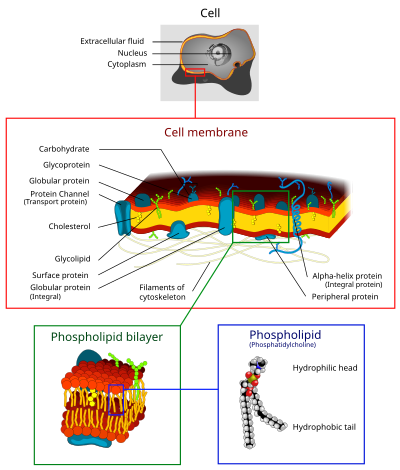
Back غشاء خلوي Arabic غشاية صيطوپلازمية ARY Membran Azerbaijani Клетачныя мембраны Byelorussian Клетъчна мембрана Bulgarian কোষ ঝিল্লি Bengali/Bangla Ćelijska membrana BS Membrana plasmàtica Catalan پەردەی خانەیی CKB Cytoplazmatická membrána Czech


The cell membrane (also known as the plasma membrane or cytoplasmic membrane, and historically referred to as the plasmalemma) is a biological membrane that separates and protects the interior of a cell from the outside environment (the extracellular space).[1][2] The cell membrane consists of a lipid bilayer, made up of two layers of phospholipids with cholesterols (a lipid component) interspersed between them, maintaining appropriate membrane fluidity at various temperatures. The membrane also contains membrane proteins, including integral proteins that span the membrane and serve as membrane transporters, and peripheral proteins that loosely attach to the outer (peripheral) side of the cell membrane, acting as enzymes to facilitate interaction with the cell's environment.[3] Glycolipids embedded in the outer lipid layer serve a similar purpose. The cell membrane controls the movement of substances in and out of a cell, being selectively permeable to ions and organic molecules.[4] In addition, cell membranes are involved in a variety of cellular processes such as cell adhesion, ion conductivity, and cell signalling and serve as the attachment surface for several extracellular structures, including the cell wall and the carbohydrate layer called the glycocalyx, as well as the intracellular network of protein fibers called the cytoskeleton. In the field of synthetic biology, cell membranes can be artificially reassembled.[5][6][7][8]
- ^ Kimball's Biology pages Archived 2009-01-25 at the Wayback Machine, Cell Membranes
- ^ Singleton P (1999). Bacteria in Biology, Biotechnology and Medicine (5th ed.). New York: Wiley. ISBN 978-0-471-98880-9.
- ^ Tom Herrmann; Sandeep Sharma (March 2, 2019). "Physiology, Membrane". StatPearls. 1 SIU School of Medicine 2 Baptist Regional Medical Center. PMID 30855799.
{{cite journal}}: CS1 maint: location (link) - ^ Alberts B, Johnson A, Lewis J, et al. (2002). Molecular Biology of the Cell (4th ed.). New York: Garland Science. ISBN 978-0-8153-3218-3. Archived from the original on 2017-12-20.
- ^ Budin I, Devaraj NK (January 2012). "Membrane assembly driven by a biomimetic coupling reaction". Journal of the American Chemical Society. 134 (2): 751–3. doi:10.1021/ja2076873. PMC 3262119. PMID 22239722.
- ^ Staff (January 25, 2012). "Chemists Synthesize Artificial Cell Membrane". ScienceDaily. Archived from the original on January 29, 2012. Retrieved February 18, 2012.
- ^ Staff (January 26, 2012). "Chemists create artificial cell membrane". kurzweilai.net. Archived from the original on January 28, 2012. Retrieved February 18, 2012.
- ^ Zeidi, Mahdi; Kim, Chun IL (2018). "The effects of intra-membrane viscosity on lipid membrane morphology: complete analytical solution". Scientific Reports. 8 (1): 12845. Bibcode:2018NatSR...812845Z. doi:10.1038/s41598-018-31251-6. ISSN 2045-2322. PMC 6110749. PMID 30150612.
© MMXXIII Rich X Search. We shall prevail. All rights reserved. Rich X Search